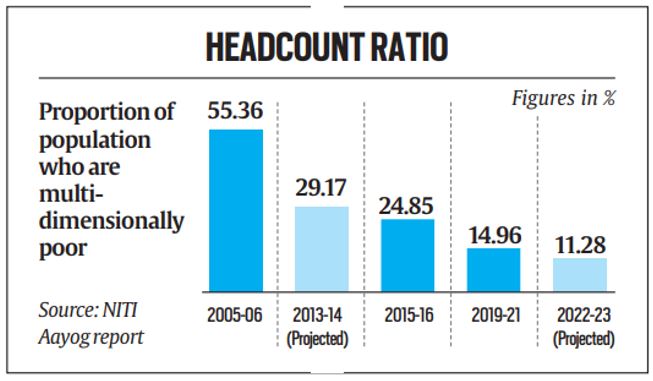

16th January 2024 (12 Topics)
Context
As per a discussion paper by NITI AYOG, India’s multidimensional poverty rate down to 11.28% in 2022-23 from 29.17% in 2013-14.
Key Highlights -
- India's Progress in Multidimensional Poverty Reduction
- Remarkable Decline in Multidimensional Poverty: India's population living in multidimensional poverty dropped from 29.17% in 2013-14 to 11.28% in 2022-23, with an estimated 24.82 crore people escaping poverty in the last nine years.
- State-wise Improvements: Uttar Pradesh, Bihar, Madhya Pradesh, and Rajasthan witnessed significant reductions in the number of people classified as poor based on the Multidimensional Poverty Index (MPI).
- Severity of Deprivation and Trends: The severity of deprivation declined, albeit at a slightly lower rate between 2015-16 and 2019-21 compared to the previous period. The discussion paper also analyzes long-term poverty trends.
- Impact of COVID-19 and Sustainable Development Goals (SDG)
- COVID-19's Influence: The paper acknowledges that the impact of the COVID-19 pandemic might not be fully reflected in the data, as NHFS-5 data collected between 2019-21 was obtained before the pandemic.
- Achieving SDG Target 1.2: India is likely to achieve Sustainable Development Goals (SDG) Target 1.2, reducing the proportion of people living in poverty in all dimensions ahead of the 2030 deadline.
- Indicators and Holistic Measurement of Poverty
- Standard of Living Dimension Improvements: Indicators related to the standard of living, such as cooking fuel and sanitation facilities, showed significant improvements over the years.
- Impact of Indicators on MPI: The sharpest decline was observed in the indicator measuring deprivation of access to bank accounts.
- State-wise Comparison: Bihar, Jharkhand, and Uttar Pradesh recorded substantial drops in the share of MPI poor, reflecting positive trends in multidimensional poverty reduction.
- Definition of Multidimensional Poverty: India's definition incorporates twelve indicators covering nutrition, mortality rates, maternal health, education, and living conditions, providing a comprehensive assessment beyond income levels.
|
The Global Multidimensional Poverty Index:
|
How we can measure poverty?
- Poverty can be defined as a condition in which an individual or household lacks the financial resources to afford a basic minimum standard of living.
- Economists and policymakers estimate “absolute” poverty as the shortfall in consumption expenditure from a threshold called the “poverty line”.
- The official poverty line is the expenditure incurred to obtain the goods in a “poverty line basket” (PLB).
- Poverty can be measured in terms of the number of people living below this line (with the incidence of poverty expressed as the head count ratio). The “depth” of poverty indicates how far the poor are below the poverty line.
- Six official committees have so far estimated the number of people living in poverty in India
- The working group of 1962
- V N Dandekar and N Rath in 1971
- Y K Alagh in 1979
- D T Lakdawala in 1993
- Suresh Tendulkar in 2009
- C Rangarajan in 2014
- The government did not take a call on the report of the Rangarajan Committee; therefore, poverty is measured using the Tendulkar poverty line.
- As per this, 21.9% of people in India live below the poverty line.
|
How poverty impacts India’s economy?
|
Expected Aftermath of reducing Multidimensional Poverty
- Socio-Economic Transformation
- Enhanced Quality of Life: Reduction in multidimensional poverty indicates an improvement in health, education, and living standards, contributing to an overall enhancement in the quality of life for millions of individuals.
- Increased Human Capital: Improved education and health outcomes result in a more skilled and healthy workforce, potentially boosting productivity, innovation, and contributing to economic growth.
- Empowerment of Marginalized Communities: Poverty reduction often leads to greater empowerment of marginalized communities, fostering social inclusion, equity, and reduced socio-economic disparities.
- Economic Impact
- Economic Growth: A healthier and more educated population is often correlated with increased productivity and economic growth, as individuals become more capable contributors to the workforce.
- Higher Consumer Demand: As people move out of poverty, there tends to be an increase in consumer spending, driving demand for goods and services and positively impacting various sectors of the economy.
- Public Health and Education
- Improved Public Health: Reduced poverty implies better access to healthcare services, leading to a decline in disease prevalence and improvements in overall public health indicators.
- Educational Attainment: Poverty reduction is associated with increased school attendance and educational attainment, fostering a more educated and skilled populace.
- Social and Environmental Implications
- Social Cohesion: Poverty reduction can contribute to greater social cohesion as communities experience improved living conditions, leading to a more stable and harmonious society.
- Environmental Stewardship: With improved living standards, there may be increased awareness and capacity for environmental stewardship, as communities focus on sustainable practices and conservation.



